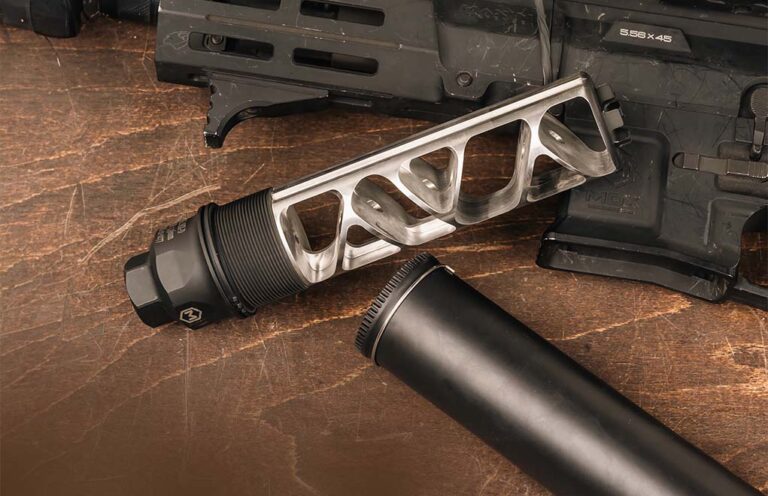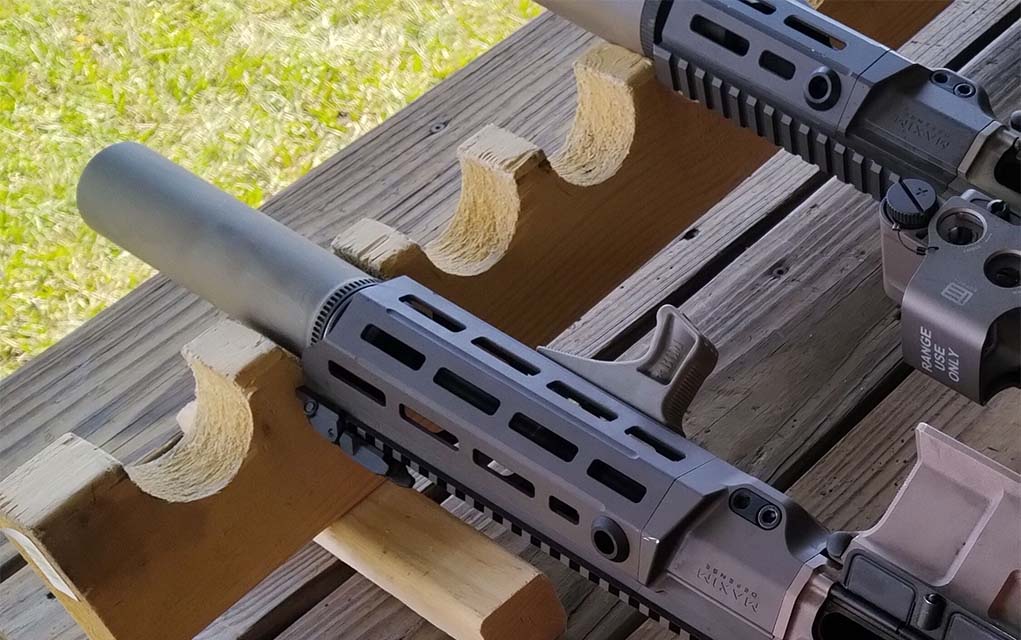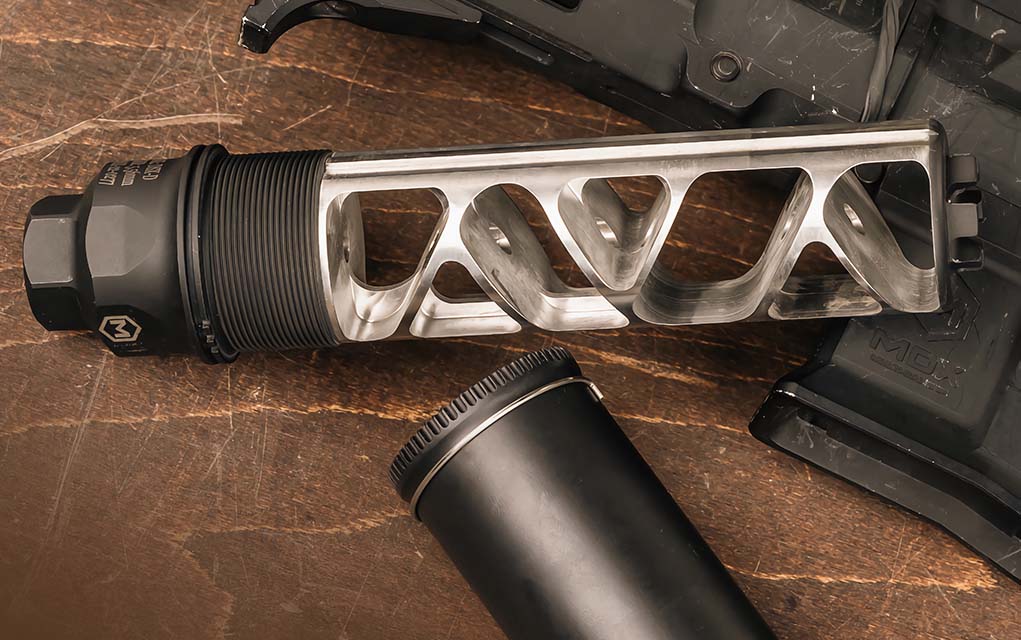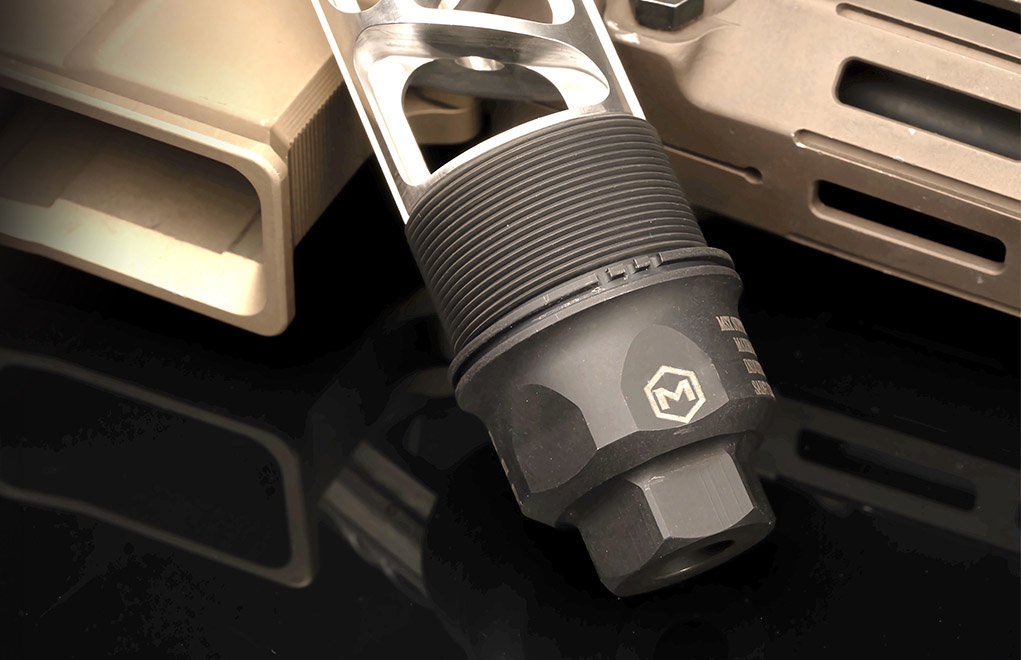
The author checks out the Maxim Defense DSX-D, a monocore suppressor specializing in short barrels.
With geometry relatively figured out and materials fairly rote, there generally isn’t much to get whomped up about when it comes to suppressors. Don’t get me wrong: There are plenty of reasons to get geeked about adding a can to a platform, but as far as leaps-and-bounds improvements on the nearly century-old device, these come along about as often as logical ATF rule changes.
That said, Maxim Defense and its DSX-D suppressor proved a breath of fresh air at CANCON Georgia last fall. Far from reinventing the wheel, the Minnesota-based manufacturer has taken a proven monocore design and enhanced it in a number of nuanced ways that allow it to stick out heads and shoulders above much of its class.
Not to mention: It’s a hell of a lot of fun to shoot.

Getting to the Core of the DSX-D
If you come looking for some radically new monocore engineering guaranteed to make your carbine, pistol or SBR quiet as a mouse fart, I’m sorry to disappoint. Overall, the DSX-D’s design is fairly traditional in its main components. That doesn’t mean the 7.9-inch-long and 1.75-inch diameter suppressor doesn’t work: The 17-4 core and titanium tube bring most 5.56 NATO carbines down to a manageable 134 dBs. But Maxim Defense achieves this through a fairly conventional core design.
Eyebrows start to rise with the ingenious tweaks the company has incorporated to make the can easier to maintain, service … and even potentially upgrade. This all starts with how the three-piece suppressor is serialized: the mount.
If you aren’t deep into these muzzle devices, this aspect might get lost on you. However, once you realize the serialized part of the suppressor is considered the suppressor itself, then Maxim Defense’s angle becomes apparent. Suffer a baffle strike? Send the core alone back to the company. Banged the heck out of the tube? Procure a new one from Maxim Defense. The company cooks up a new and improved core? Just buy it.
And mind you, all of this without the fuss and muss of NFT regulation and tax stamps. Now that’s convenient and goes a long way in making the DSX-D about as hassle-free as suppressors come—obviously after jumping the hoops in initially buying one.


Clean As a Whistle
Regardless of whether you’ve considered it, when you buy a suppressor, you take on the obligation of cleaning another piece of kit. For all the device’s positives, that’s one big bummer about suppressors (aside from price and regulations). But life is made a bit easier with DSX-D and how the user-serviceable can is designed, which is to make cleaning as pain-free as possible.
When it comes to monocore suppressors, the core itself isn’t generally the dirty part—the interior of the tube is the offender. Carbon builds up on the walls, requiring a good bit of elbow grease to dislodge it after disassembly. A genius move with the DSX-D is Maxim Defense has engineered a cleaning system that works by simply taking the suppressor apart.
Called carbon cutters by Maxim, the top and bottom of the core have a sharp ridgeline running the length of the component. As its name suggests, the rather eloquent addition to the internals cuts the carbon off the interior of the tube simply through the act of unscrewing the core. To that end, Maxim Defense has put a lot of thread on the tube and mount, ensuring a thorough scraping of the built-up gunk.


Sized Right
Truth be told, the DSX-D is a bit on the chunky side in its diameter. But, the can is sized right for length, particularly when it comes to abbreviated barrel guns. A little elementary school math and it’s easy to deduce that, when added to a 10.3-inch barreled gun, it brings the length to a flat 16 inches. It’s almost like Maxim Defense planned it that way.
Indeed, the company did, making the directly threaded suppressor capable of being pinned and welded. Doing so takes a two-stamp gun and makes it a one-stamp affair before purchase, which for anyone who’s gone through the paperwork rigmarole, makes for a lot less hassle. Not to mention, $200 extra in your pocket.
Shooting The DSX-D
Honestly, this can feels and sounds phenomenal. I tested the DSX-D on a 10.3-inch barreled, full-auto Maxim carbine at CANCON, and not only did it mute the 5.56 NATO to a near whisper, but it had next to nothing for backpressure. For short guns, this is a distinctive advantage in terms of maintaining situational awareness, but also a lot healthier in the long run.
Better yet, the suppressor made the SBR a snap to keep on target. Three-round bursts stacked shots practically on top of each other, while mag dumps were incredibly controllable—center mass all day long.
As a full-auto-rated, short-barrel-rated suppressor, it’s tough to beat what the DSX-D brings to the table. All the added extras make dang near a must-have for serious suppressed shooters.
Editor’s Note: This article originally appeared in the Suppressor Special 2024 issue of Gun Digest the Magazine.
More On Suppressors:


Next Step: Get your FREE Printable Target Pack
Enhance your shooting precision with our 62 MOA Targets, perfect for rifles and handguns. Crafted in collaboration with Storm Tactical for accuracy and versatility.
Subscribe to the Gun Digest email newsletter and get your downloadable target pack sent straight to your inbox. Stay updated with the latest firearms info in the industry.





